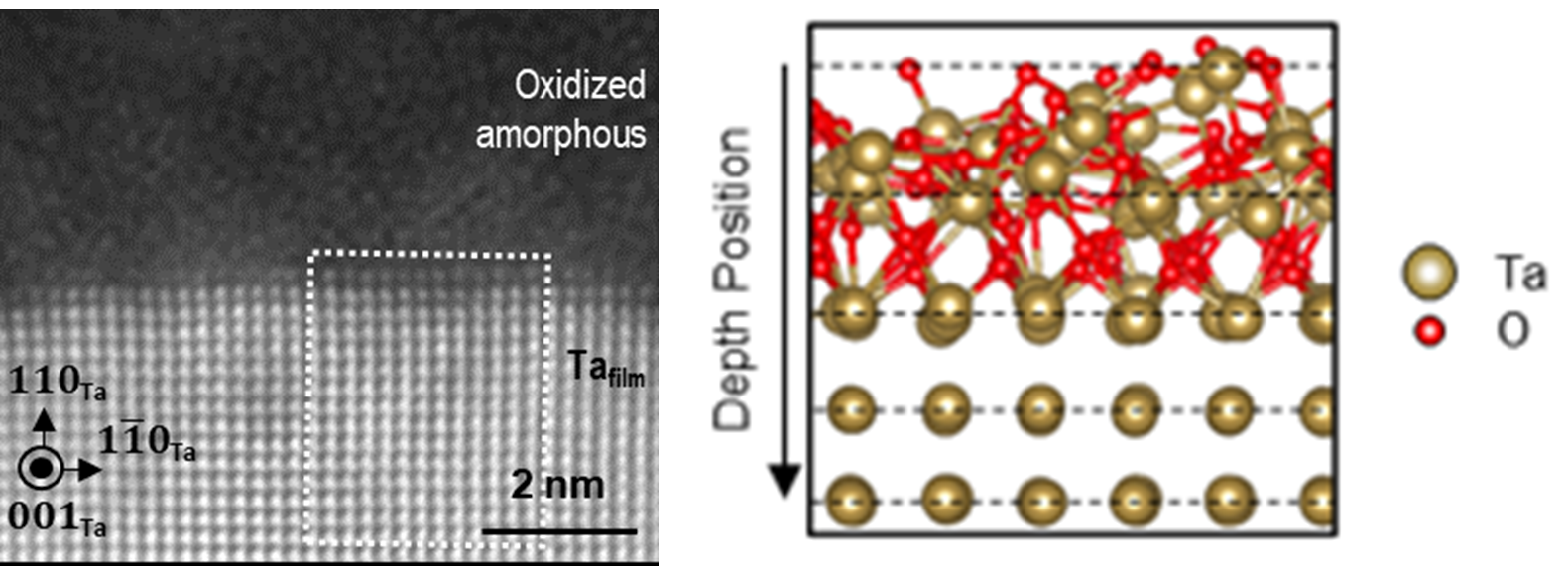Researchers Build an Atomic-Level Model of Oxidization on the Surface of Tantalum Film
Advanced electron microscopy and first principles calculations reveal atomic motifs at the oxidized surface of superconducting tantalum film.

The Science
Tantalum is a superconducting material that shows great promise for making qubits, the building blocks of a quantum computer. When an oxide layer forms on the surface of tantalum, it can impede tantalum’s ability to retain quantum information. Learning how the layer forms may help scientists understand why it happens and potentially how to prevent quantum computers from losing information. In this study, researchers used scanning transmission electron microscopy and computer modeling to investigate the structure of superconducting tantalum film. This helped them build an atomic-level understanding of the crystalline lattice of tantalum metal and the oxide that forms on its surface. This revealed intriguing new details about the interface between these layers.
The Impact
Recent advances in superconducting qubit technology have led to significant progress in quantum computing. However, researchers need to solve the challenge of decoherence. This is the loss of information stored in qubits that occurs when the qubits interact with their environment. In most superconducting qubit systems, including those based on tantalum, surface oxidation is the primary source of quantum decoherence. Scientists need to understand the oxidation process at the atomic scale to make progress toward a practical quantum processor. This research provides important insights into the formation and atomistic model of the surface oxides of a superconducting qubit tantalum film.
Summary
In this study, researchers at Brookhaven National Laboratory and Pacific Northwest National Laboratory investigated the surface oxidation mechanism of native tantalum (Ta) films and its potential impact on the lifetime of superconducting qubits. They investigated these topics using a combination of electron energy loss spectroscopy (EELS), four-dimensional STEM (4D-STEM), multivariate curve resolution (MCR) analysis, and density functional theory calculations. Specifically, the team quantified the concentration of the chemical species with angstrom-resolution at the interface and identified a few-angstrom thick crystalline suboxide (TaO1-δ) layer sandwiched between Ta metal and Ta2O5 that was never known before.
The results suggest an atomistic model of the oxidized Ta(110) surface, showing that oxygen atoms tend to penetrate the Ta surface and accumulate between the two outermost Ta atomic planes; oxygen accumulation at the level exceeding a 1:1 O/Ta ratio drives disordering and, eventually, the formation of an amorphous Ta2O5 phase. In particular, 4D-STEM based fluctuation electron microscopy produced results that were consistent with the chemical profiles obtained from the EELS mapping, revealing the crystalline nature of the Ta suboxide (TaO1−δ (δ < 0.1)). Subsurface oxidation leads to charge redistribution and electric polarization, potentially causing quasiparticle loss and decreased current-carrying capacity, thus affecting superconducting qubit coherence. The findings enhance the comprehension of the realistic factors that might influence the performance of superconducting qubits, thus providing valuable guidance for the development of future quantum computing hardware.
Contact
Mingzhao Liu
Center for Functional Nanomaterials
Brookhaven National Laboratory
mzliu@bnl.gov
Yimei Zhu
Brookhaven National Laboratory
zhu@bnl.gov
Funding
This work is supported primarily by the Department of Energy (DOE) Office of Science, National Quantum Information Science Research Centers, Co-design Center for Quantum Advantage (C2QA). This research used resources of the Center for Functional Nanomaterials at Brookhaven National Laboratory and the National Energy Research Scientific Computing Center, both DOE Office of Science user facilities.
Publications
Mun J., et al., Probing Oxidation-Driven Amorphized Surfaces in a Ta(110) Film for Superconducting Qubit. ACS Nano 18, 1126 (2024). [DOI: 10.1021/acsnano.3c10740]
Related Links
Direct View of Tantalum Oxidation that Impedes Qubit Coherence, Brookhaven National Laboratory newsroom
Highlight Categories
Program: Hubs
Performer: CFN



